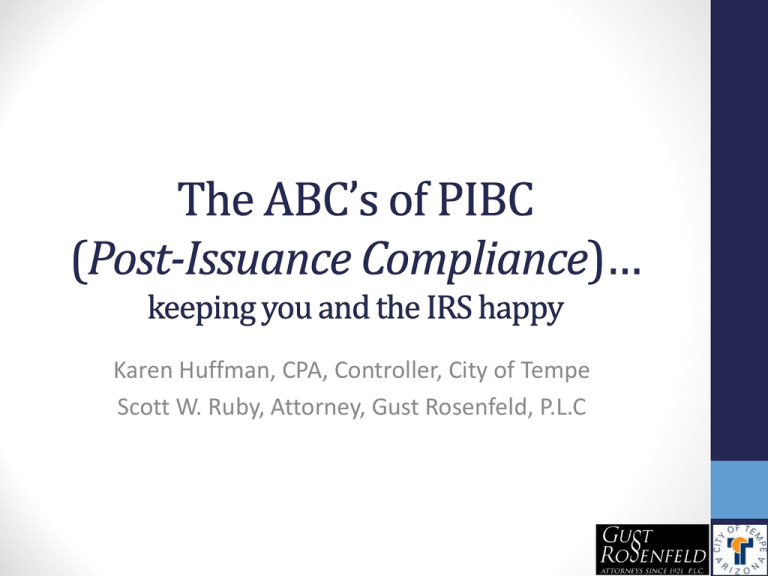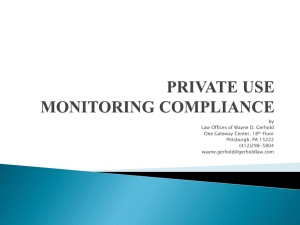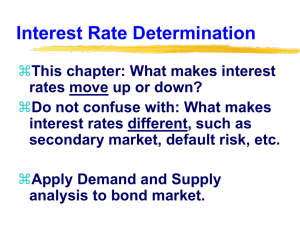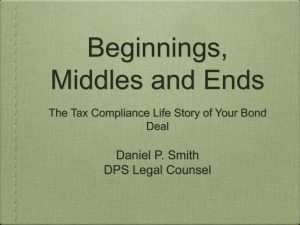Arbitrage Bonds
advertisement

Karen Huffman, CPA, Controller, City of Tempe Scott W. Ruby, Attorney, Gust Rosenfeld, P.L.C Issuance of Debt •Post Issuance Bond Compliance ABC’s of PIBC • Legal Expert • What is included in the law • What does it mean • Practical Aspect • What did the City of Tempe do • What challenges did we face Post-Closing (What's That?) Tax-advantaged bonds are subject to federal tax requirements BOTH at the time of issuance AND so long as the bonds remain outstanding. IRS is concerned about issuers post-issuance compliance and is “encouraging” adoption of written post-issuance compliance policies. IRS concern has manifested into a post-closing compliance initiative. Governmental issues are now on the radar screen. IRS wants issuers to focus on continued monitoring and better record keeping. Your Obligation Develop a post-compliance program. Retain certain records. Monitor private business use of financed facilities; and changes in use. Track and Monitor Payments that Result from Financed Facilities. Track Investment of Bond Proceeds and monitor the use of bond proceeds Calculate Arbitrage and Pay Rebate or Yield Reduction. Respond to IRS inquiries. Specific Focus of a Post-Closing Compliance Program Assign responsibility. Train responsible person and others who work with bonds and bond financed property Develop a system to monitor compliance that is integrated with existing accounting systems and will allow timely discovery and correction of any problems. Record retention must be for LIFE OF BONDS plus 3 years - - who will be around? Alert! Alert! Tax-advantaged bonds are subject to federal tax requirements BOTH at the time of issuance AND so long as the bonds remain outstanding. IRS Form 14002 Retain Certain Records Basic records: Transcript Ordinances Opinion Documentation evidencing expenditure of bond proceeds. Documentation evidencing all sources of payment or security for bonds. Documentation pertaining to any investment of bond proceeds. Remember, the burden of proof is on you to establish the bonds are Tax-Exempt if you are audited – you can only do so through records. Life of Bonds + 3 Years • Biggest Challenge: • AP Invoices Monitor Private Business Use of Financed Facilities What was intended use of facility being financed by the bonds? Who “owns” it? (Use federal tax definition of owner). Who was using it, who is using it, and who may use it? Is there any “bad” use? How much? (10% and 5% Rules). Practical difficulties – your the CFO … who else has control of the building and programming? (Need for formal policy and procedures.) Track and Document Changes in Use Create central repository, clearinghouse process through your office. Review (before it happens) any change in the use of the financed facilities. Changes in use can trigger change in the tax status if not done properly and the changes and tax impact are very fact intensive Track and Monitor Contracts/Leases that Touch Financed Facilities Types of Relationships that create private use: Leases Management and Services Contracts Research Contracts “Partnerships” with private uses? Sales agreements Take or Pay Contracts Land Use agreements, easements, naming rights, licenses Track and Monitor Payments that Result from Financed Facilities Review Payments from Users of the Facilities Regardless if Used to Pay Debt Service. Lease Payments. Payments from Management Contracts. Proceeds from Sale of Facilities. Allowed to Reduce Payments by Operating Expenses. Monitoring Private Use Investment of Bond Proceeds Allowable Investments: Proceeds may be restricted to tax-exempt (non-AMT) investments depending on use of the proceeds, initial expenditure projections, and/or other bond covenants Investments must comply with ALL of the following: Arizona statute for investment of public funds Issuer's investment policy Authorized investment list included in bond covenants (if applicable) Investment of Bond Proceeds Investments beyond any qualifying temporary period may have further restrictions – check with bond counsel and/or your bond documents to ensure compliance Initial investment of proceeds: Match investment maturity dates and amounts to the project draw schedule If the issue may qualify for a spending exception to rebate; be sure to structure your portfolio to accommodate the timing of the expenditures No investments should mature beyond the temporary period (if applicable) in the initial portfolio. Reimbursement With Bond Proceeds Bond proceeds can be treated as spent (no longer need to track the investment of the money) if used to reimburse the issuer for certain qualifying prior expenditures. Expense was paid no earlier than 60 days prior to declaration of official intent to reimburse. Reimbursed not more than 18 months after the facility was placed in service or 3 years after bonds are sold. Exceptions exist for certain preliminary expenditures. City of Tempe’s Debt Practices Typical Debt Issuance Prior Year Expenditures Up-coming Year’s Anticipated Expenditures Current Year’s Bond Issuance Reimbursement + Investment • Immediate reimbursement of funds spent • Remaining investment in LGIP or Trust Account • Advantage- meeting 24 month arbitrage spending exception + temporary period • Disadvantage- using City’s cash initially Arbitrage Bonds Bonds become taxable if the Bond is an arbitrage bond. Arbitrage bond exists if the issuer violates either the: 1. 2. Yield restriction requirement; or Rebate requirement. Yield Restriction Requirement: Gross proceeds cannot be invested in a materially higher yield; A materially higher yield is (some exceptions): 1. 2. 3. Governmental Project Bonds: 1/8 of 1% (.125%) greater than the bond yield; Refunding Bonds: 1/1000 of 1%; and Other Types of Bonds: Other limits. Arbitrage Bonds (cont’d) Exceptions to Yield Restriction Requirement. Investment in tax-exempt bonds (non-AMT). Temporary period for construction fund (3 years) or bona fide debt service fund (13 months). Reserve or replacement fund. Minor portion: lesser of 5% of sales proceeds or $100,000. Bonds must also “pass” the reasonable expectations test. Can lower the yield with yield reduction payments (some exceptions). Arbitrage Bonds (cont’d) Rebate Requirement. Certain earnings must be rebated (e.g. earnings on the construction, reserve and debt service funds). Exceptions to Rebate. Small Issuer: governmental issuer who issues less than $5 million of tax-exempt obligations in the year. Spending: (1) 6 months – spending 100%; (2) 18 months, spend certain percentages by 6, 12 and 18 months; (3) 24 months (construction bonds), spend certain percentages by 6, 12, 18 and 24 months. (Still rebate on reserve and debt service funds). Bona Fide Debt Service Fund: If $100,000 or less. Arbitrage Rebate and Yield Reduction Calculations Issuer is responsible for rebate and yield reduction calculations: Calculations must be completed every 5 years (IRS) and payment remitted if required Calculations are typically done more frequently (annually, monthly..) to monitor and track liabilities and spending exceptions if applicable A rebate fund must be established if a liability exists to set aside funds for payment If calculations show no payments are due, no reporting is required to the IRS Arbitrage Rebate and Yield Reduction Calculations (cont’d) Choose accounting method with respect to bond proceeds and interest earnings, investment, and expenditures. Obtain computation of “yield” of bonds and establish procedure to track investment returns. Establish procedure for allocation of bond proceeds and interest earnings to expenditures, including reimbursement of pre-issuance expenditures. Tips to Avoid Becoming an Arbitrage Bond (cont’d) Monitor compliance with “temporary period” expectations for expenditure of bond proceeds, typically 3 years for new money bonds, and provide for yield restriction of investment or “yield reduction payments” if expectations are not satisfied. Establish procedures to ensure investments acquired with bond proceeds are purchased at fair market value. These can include use of bidding procedures under regulatory safe harbor. Tips to Avoid Becoming an Arbitrage Bond (cont’d) Avoid formal or informal creation of funds reasonably expected to be used to pay debt service on bonds without determining in advance whether such funds must be invested at restricted yield. Consult with bond counsel before engaging in postissuance credit enhancement transactions (e.g., bond insurance, letter of credit) or hedging transactions (e.g., interest rate swap, cap). Identify situations in which compliance with applicable yield restrictions depends upon later investments, (e.g., purchase of 0% SLGS from U.S. Treasury), and monitor implementation. Tips to Avoid Becoming an Arbitrage Bond (cont’d) Monitor compliance with 6-month, 18-month, or 2-year spending exceptions to rebate requirement. Arrange for timely computation of rebate liability and, if rebate is payable, for timely filing of Form 8038-T and payment of rebate. Rebate is ordinarily due at 5-year intervals. Arrange for timely computation and payment of “yield reduction payments,” if applicable. Issuers/borrowers frequently engage outside arbitrage/rebate consultants to do such computations. Tracking Expenditures Debt Service Fund IRS Summary The tax-issues do not go away once you close the bonds. Continuing obligations are important. Uses of your buildings that were financed with bond proceeds will probably change over 20 plus years. IRS is becoming much more active in policing postissuance compliance matters Consequences of non-compliance: Bonds could forfeit their tax-exempt status.









